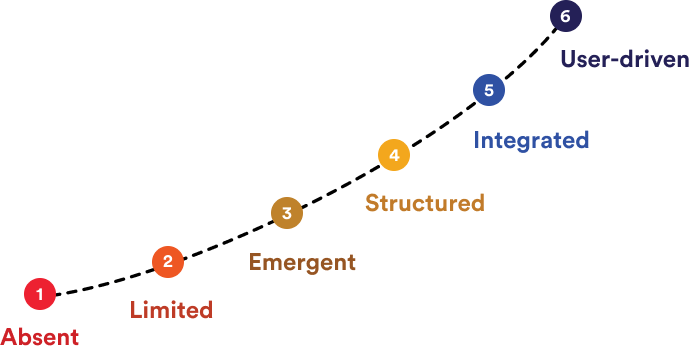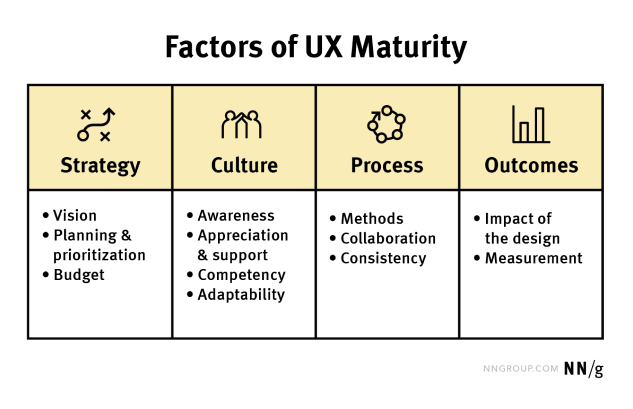Maturity Model for User Experience Evolve into a User-Centered Business
June 8, 2023 | Read Time : 3 mins
Table of Contents
Introduction
In today’s competitive business world, providing great user experiences (UX) is essential for success. Companies that prioritize putting users at the center of their design and operations gain a significant advantage. To achieve this, businesses need a structured approach to assess their UX maturity and guide their journey toward becoming truly user-centered. In this blog post, we will explore the concept of a UX maturity model and discuss how it can help organizations evolve their UX practices.
Understanding UX maturity
To start, let’s understand the different stages of UX maturity:
- Ad hoc: UX efforts are random at this stage and lack a formal structure. Companies may not fully realize the value of UX or have dedicated UX resources. User feedback and usability testing might be rare, making it difficult to understand what users need.
- Defined: In this stage, companies recognise the importance of UX and begin to establish dedicated UX teams and processes. User research and usability testing become more organised, and UX design principles are integrated into product development. However, UX efforts might still be isolated and not fully integrated into the business strategy.
- Optimised: At the highest level of UX maturity, companies embrace user-centeredness as a core value. UX processes are standardised and integrated throughout the organisation, creating a culture that values and prioritises user experience. Continuous user research, data-driven decision-making, and iterative design become the norm.

Benefits of advancing UX maturity
To start, let’s understand the different stages of UX maturity:
- Happier Customers: Companies can create products and services that meet customer expectations by understanding user needs. This leads to greater customer satisfaction, loyalty, and positive recommendations
- Competitive Edge: Companies with advanced UX maturity stand out from competitors by offering exceptional experiences. By providing intuitive and enjoyable interactions, they attract and keep customers, giving them an advantage in the market.
- Cost Savings: Investing in UX maturity reduces the risk of developing products that don’t meet user expectations. Early identification of usability issues through user testing helps avoid costly redesigns and saves time and resources.
- Increased Sales: A user-centered approach improves conversion rates by smoothing the user journey. Clear and user-friendly interfaces lead to higher engagement, more sales, and increased revenue.
Nurturing UX maturity
To advance along the UX maturity model, businesses should follow these key steps:
- Leadership Support: Company leaders need to prioritize and support UX, making it part of the company culture. They should allocate resources, encourage team collaboration, and consider UX in important decisions.
- User Research and Testing: Regularly research users’ needs and preferences. Test your designs with users to validate decisions and catch problems early on.
- Team Collaboration: Encourage collaboration between UX professionals, designers, developers, and other stakeholders. Working together ensures that everyone contributes to creating user-centered designs.
- Measure and Improve: Establish metrics to assess UX performance and continuously improve based on user feedback. Making data-based decisions helps align design choices with user expectations and business goals.
Important building blocks for UX maturity
To advance along the UX maturity model, businesses should follow these key steps:
- UX Strategy: A clear plan that aligns business goals with user needs. It involves setting objectives, defining target users, and establishing design principles that guide the creation of user-centered experiences.
- User Research and Insights: Learning about users through research to gain deep insights into their behaviors, motivations, and challenges. This helps tailor products and services to meet their needs better.
- Design and Prototyping: Creating easy-to-use interfaces and interactive prototypes that bring the user experience to life. It allows for testing and feedback to improve the design before final implementation.
- Usability Testing and Improvements: Observing users as they interact with prototypes or existing products to uncover problems and gather feedback. This helps make iterative improvements and create more intuitive and user-friendly designs.
- UX Culture and Collaboration: Building a work environment where everyone values and prioritizes user-centered design. Collaboration among different teams, from designers to developers and business leaders, is crucial for successful UX integration.

Measuring UX maturity
It’s important to use meaningful measurements to track progress in UX maturity. Here are some key metrics to consider:
- User Satisfaction: Assessing users’ satisfaction through surveys, feedback, or ratings to understand their overall experience.
- Usability Metrics: Using measures like task success rate, error rates, and time on task to evaluate how well users can complete tasks and navigate the interface.
- Conversion and Engagement: Tracking conversion rates, click-through rates, and user engagement metrics to see how UX improvements impact business outcomes.
- User Feedback: Gather qualitative feedback through interviews or testing sessions to gain insights into user perceptions and needs.
- Organisational Alignment: Evaluating the integration of UX practices within the organization, including collaboration, shared understanding of UX principles, and support from different departments.
Overcoming challenges in the UX journey
The journey to UX maturity comes with challenges. Here are some common obstacles and strategies to overcome them:
- Limited Resources: Prioritising UX investments, seeking external expertise if needed, and advocating for the importance of UX within the organisation.
- Resistance to Change: Communicating the benefits of user-centred approaches, sharing successful case studies, and addressing concerns to overcome resistance.
- Shifting Organisational Culture: Gaining leadership support, fostering team collaboration, and providing ongoing education and training to promote a UX-focused culture.
- Balancing User Needs and Business Goals: Finding a balance between meeting user needs and achieving business objectives by aligning UX efforts with the overall business strategy and involving stakeholders in decision-making.
- Staying Agile and Adaptive: Embracing iterative design, staying updated with industry trends, and continuously learning and adapting to meet changing user expectations and technological advancements.
Continuous growth and improvement
UX maturity is an ongoing journey. It requires organizations to continuously strive for improvement, embrace a growth mindset, and adapt strategies. Regularly assessing UX maturity, setting new goals, and fostering a learning and user-centric culture are key to staying ahead and delivering exceptional experiences.
Becoming a user-centred business
Transitioning into a user-centred business involves more than just reaching UX maturity. It requires a comprehensive approach that integrates user-centricity into the entire organization. Here’s how businesses can evolve into a user-centred mindset:
- Putting Customers First: Create a culture that prioritizes customers and their needs. Encourage empathy and a deep understanding of the user’s perspective across all departments. Value customer feedback and make decisions with their best interests in mind.
- Collaboration Across Teams: Foster collaboration and communication between different teams to break down barriers and ensure that user-centered principles are embraced company-wide. Encourage cross-functional teams to collaborate on UX projects and share their knowledge and insights.
- Let Users Drive Decisions: Base decisions on user research and data. Use real user insights to guide product and design choices instead of relying on assumptions or personal preferences. Regularly involve users in the feedback process to ensure their needs are met.
- Continuous Learning and Improvement: Foster a culture of ongoing learning and improvement. Stay updated on industry trends, emerging technologies, and changing user expectations. Actively seek user feedback and use it to make iterative improvements to the user experience.
- Support from Leadership: Gain support from company leaders who champion the importance of user-centered design. Leaders should allocate resources and actively participate in and promote user-centric initiatives. Their support creates a culture that values and invests in the user experience.
Reaching UX maturity begins the journey toward becoming a user-centered business. Organizations can transform into entities that truly prioritize their users by fostering a culture that prioritizes customers, promoting collaboration across teams, letting users drive decisions, embracing continuous learning, and gaining leadership support. Becoming a user-centered business allows companies to build strong customer relationships, outperform competitors, and thrive in a dynamic business environment where the user experience is paramount.






